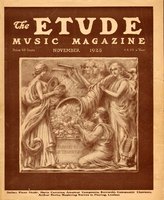By MR. ROBERT BRAINE
Vibrato Trouble
M. B. P.—I cannot tell exactly where your trouble lies without hearing and watching you play. I have no doubt however, that when doing the vibrato your left arm shakes the violin, causing the bow to jump. The vibrato should be done from the wrist, and not with the whole arm, and the violin should be held still while doing it. 2.—The notes in the passage you send are written as double stops, but only one sound is intended to be produced. The lower note shows what string the harmonic is to be produced on, and the upper note shows the point on the string where the finger is to be placed. For instance, the first note is played by placing the fourth finger very lightly on the open A string, the third note is produced by the third finger on the open A, and the last note in the passage by the third finger on the open D. These are harmonics. 3.—As it is rather difficult to produce harmonics clearly at first, it might be a good idea to have a good violin teacher demonstrate these harmonic tones for you.
Playing Fifths
V. I. I.—The distances from the first to the fourth finger would be the same in playing the octave passages in the first position you describe. There might be a variation in the distances if your strings were not perfectly true in fifths, or if your violin were not in perfect tune; possibly also your fingerboard is in bad condition, which might alter the tones to some extent. I could not advise you without examining your violin and hearing you play. 2.—As to your difficulty in playing fifths, maybe your strings are too far apart, or your strings are not true in fifths (quintenrein, as the Germans call it). You must place your finger with the tip squarely on both strings, seeing that the two strings are stopped at the same distance from the end of each string.
“Perpetual Motion”
S. G.—Violin pieces of the “Perpetual Motion” type, such as the famous ones by Ries and Paganini, are played with springing bow. They do not give the proper effect at all, when the bow is kept pressed on the string in legato style.
Left-Handed Playing
W. H. C.—Occasionally a violin player who bows normally with the right arm, meets an injury to the fingers of the left hand, which makes it impossible for him to use them in fingering, but which is of such a nature, that it is possible for him to hold the bow reasonably well with the left hand. If he wishes to continue his violin playing, his only recourse is to commence all over again, using the left as the bow arm. Whether he meets with much success depends largely on his age when the injury was sustained. If when comparatively young, he stands a good chance of getting back a portion of his technic at least. We often hear of people who have had their right hand injured who learn to write and draw with the left hand with considerable facility. 2.—A good left-handed violinist might stand some show of getting into a small theater or dance orchestra, but not into a symphony orchestra, because in a symphony orchestra all the violinists playing the same part must bow alike, and one or more violin players bowing with their left arms would spoil the appearance of the orchestra in bowing. 3— Probably your violin moves and jerks when playing the vibrato because you do your vibrato with the whole arm instead of entirely from the wrist, and this shakes the violin. 4.—Try using only the wrist in doing the vibrato: and, in the practicing, try holding the violin with the scroll resting on a book case or other article of furniture of suitable height. In this way you may learn to hold violin perfectly still.
Self-Teaching
R. T.—Your idea of spending the money you have saved up for your violin education for a fine violin, and then trying to learn without a teacher is all wrong. It would be wiser not to spend so much on your violin, and leave the major part of your savings to pay for instruction from a really good violin teacher If you try to learn by yourself, you will inevitably acquire faults in your bowing and other technic, which it will be practically impossible to eradicate, if you ever wish to learn to play the violin really correctly.
Dates on Violins
G. F.—The great violin makers dated tbeir labels according to the year in which their violins were completed. Thus, if your Stainer violins are genuine, one was made in the year 1627 and one in 1660. However, as Stainer was born in 1621, he could not have made the first named, as he would have only been six years of age. He made violins as late as 1677, so that he could have made the second one, There is hardly one chance in a million that your violins are genuine, as imitation Stainers are as the grains of sand on the seashore. Have an expert examine your violins.



